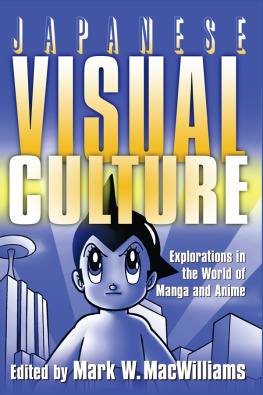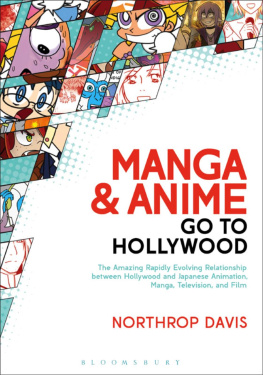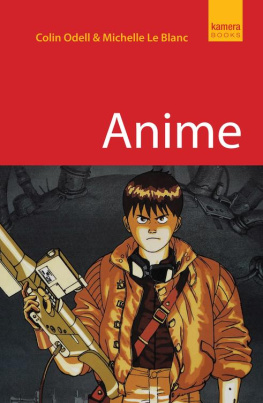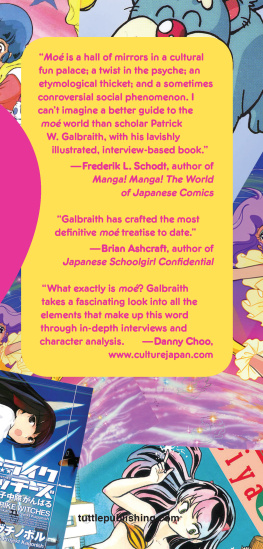J A P A N E S E
VISUAL
CULTURE
J A P A N E S E
VISUAL
CULTURE
Explorations in
the World of
Manga and Anime
Edited by Mark W. MacWilliams
Forewords by Frederik L. Schodt
First published 2008 by M.E. Sharpe
Published 2015 by Routledge
2 Park Square, Milton Park, Abingdon, Oxon OX14 4RN
711 Third Avenue, New York, NY 10017, USA
Routledge is an imprint of the Taylor & Francis Group, an informa business
Copyright 2008 Taylor & Francis. All rights reserved.
No part of this book may be reprinted or reproduced or utilised in any form or by any electronic, mechanical, or other means, now known or hereafter invented, including photocopying and recording, or in any information storage or retrieval system, without permission in writing from the publishers.
Notices
No responsibility is assumed by the publisher for any injury and/or damage to persons or property as a matter of products liability, negligence or otherwise, or from any use of operation of any methods, products, instructions or ideas contained in the material herein.
Practitioners and researchers must always rely on their own experience and knowledge in evaluating and using any information, methods, compounds, or experiments described herein. In using such information or methods they should be mindful of their own safety and the safety of others, including parties for whom they have a professional responsibility.
Product or corporate names may be trademarks or registered trademarks, and are used only for identification and explanation without intent to infringe.
___________________________________
Published with support from the Japan Foundation
___________________________________
Library of Congress Cataloging-in-Publication Data
Macwilliams, Mark Wheeler, 1952
Japanese visual culture : explorations in the world of manga and anime / edited by
Mark W. MacWilliams.
p. cm.
Includes bibliographical references and index.
ISBN 978-0-7656-1601-2 (cloth : alk. paper)ISBN 978-0-7656-1602-9 (pbk. : alk. paper)
1. Comic books, strips, etc.JapanHistory and criticism. 2. Animated filmsJapan
History and criticism. I. Title.
NC1764.5.J3M33 2008
741.5952dc22 | 2007025425 |
ISBN 13: 978-0-765-61602-9 (pbk)
ISBN 13: 978-0-765-61601-2 (hbk)
Contents
Frederik L. Schodt
Mark W. MacWilliams
Kinko Ito
Gilles Poitras
Susanne Phillipps
Lee Makela
Mizuki Takahashi
Deborah Shamoon
Yulia Mikhailova
Eldad Nakar
Richard A. Gardner
Rajyashree Pandey
Hiroshi Yamanaka
Shiro Yoshioka
Melek Ortabasi
Jaqueline Berndt
By September 4, 2006, it was clear to me that manga had truly conquered North America. That week, the New Yorker magazine featured on its cover a cartoon titled Back to Cool, showing an average American teenager slouching back to school, his brain depicted as an enlarged map divided into zones of interest. There, along with MySpace, Video iPod, PS3, Snoop Dogg, Algebra, and YouTube, was a large zone labeled Manga. There was no translation of the word, of course, andwith the market for English versions of both manga and anime now estimated to be in the billions of dollarswho would need one?
I never dreamed that manga and anime would become so popular outside of Japan. I personally became interested in manga, especially, back in 1970, when I was an undergraduate Asian Studies major attending a university in Tokyo and trying to learn Japanese. I noticed that my fellow Japanese students seemed to be spending far more time reading giant weekly manga magazines than they did cracking their textbooks, and it did not take me long to become hooked, too. Manga were fabulous entertainment, and I could easily rationalize reading them as a way to learn Japanese.
In the process I also eventually discovered that manga are much more; they are an open window onto the Japanese id, a viewnot necessarily of reality itselfbut of a cultures aspirations, dreams, nightmares, fantasies, and fetishes. As is often noted, Japan is a culture where the difference between public and private realities, and appearance and reality, is often great. In this context, for non-Japanese trying to fathom what is really going on, both manga andto a lesser extentanime can be an immense aid in bridging the disconnect. It is especially true because Japan is today one of the only countries in the world where comic books have become a full-fledged medium of expression, on par with novels and films, and read by what often seems to be everyone.
At the time, the idea of going to graduate school was not particularly appealing to me, but I can recall at one point vaguely and naively thinking thatif I failed to find anything else suitableperhaps I could someday do research on manga at a university in America. It seemed like a wonderful way to counter what then sometimes seemed to be an overemphasis in academia on the more formal aspects of Japanese culturein effect, to use manga as a tool to understand what was really going on. But I had no idea of how to implement this idea, and it remained a fantasy.
I went on to become an interpreter, translator, and occasional writer, and I managed to continue my interest in manga in other ways. Around 1977, in the belief that more people outside of Japan should know about manga, some friends and I began translating a few of the better-known ones. But it was still an era in which most Americans had never tried sushi and knew little about Japan, especially its popular culture. I soon realized that it was too early for manga to be read or accepted in the United States, at least, so I therefore set out to write a book that would introduce the manga phenomenon to non-Japanese. This became my first book, Manga! Manga! The World of Japanese Comics (1983). The main idea was to draw peoples attention to an interesting social phenomenon andif possibleencourage them to read manga.
When I finished my manuscript I had a good-natured argument on the phone with my editor, Peter Goodman, about the title. I wanted to use Japanese Comics: The New Visual Culture. He wanted something more pop, and advocated for Manga! Manga! in the main title. I was afraid that by putting manga in the title that the book would be filed next to manganese in library card catalogs (which were of course then the main way people located books), or that most people in bookstores would think the book I had slaved over so long had something to do with Italian cooking.
My book never sold many copies, but eventually the manga/anime phenomenon in Japan itself became so huge that the rest of the world could not ignore it. Fans mushroomed in other Asian countries, then in Europe, and finally in North America, where in the last two decades they have exploded in number. It is energetic fans who have proselytized on behalf of their favorite stories and characters, and pushed for greater acceptance of the material they enjoy, encouraging reluctant publishers to expand their lists and include translated manga, or pushing broadcasters to devote more time to anime shows. The reasons for the popularity of manga and anime in North America are varied and complex, but probably can best be summarized by saying that manga and anime are great fun, and also demonstrate the true potential of comics and animationboth of which were first developed in North America but were later neglected and ghettoized as entertainment for juveniles or emotionally immature adults.














